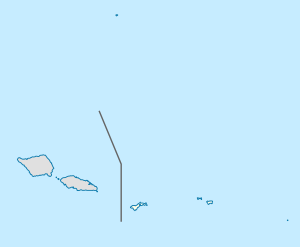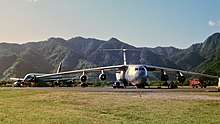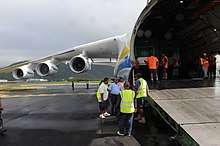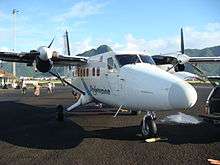Tafuna, American Samoa
Tafuna (Samoan: Tāfuna) is a village on the east coast of Tutuila Island, American Samoa. It is located on a mile north of Pago Pago International Airport (Tafuna Airport) and one mile south of Nu'uuli, American Samoa. The Ottoville district is a part of Tafuna. Near the Catholic church at Ottoville is an archeological park containing a well-preserved ancient Polynesian mound as well as a rainforest reserve.[2] Tafuna is located on the Tafuna Plain, which is the largest flatland on the island of Tutuila.[3][4][5]
Tafuna, American Samoa | |
|---|---|
Village | |
| Tafuna | |
 Tafuna seen from A'oloau | |
 Tafuna, American Samoa | |
| Coordinates: 14°20′09″S 170°43′12″W | |
| Country | |
| Territory | |
| County | Tuālāuta |
| Area | |
| • Total | 2.53 sq mi (6.54 km2) |
| Population (2010) | |
| • Total | 7,945[1] |
| • Density | 3,190.5/sq mi (1,231.9/km2) |
| ZIP code | 96799 |
Tafuna is the most populous village in American Samoa,[6] with a population of 7,945 according to the 2010 U.S. Census,[1] and is the center of nightlife on the island. The Cathedral of the Holy Family (1986) located in the village is the episcopal see of the Roman Catholic Diocese of Samoa–Pago Pago.[7]
Tafuna is home to several park areas operated by American Samoa Parks and Recreation, including Lions Park, Tia Seu Lupe and Tony Sola'ita Baseball Field.[8] Solaita Baseball Field is named after Tony Solaita, the first American Samoan to play in Major League Baseball.[9]:339 He was murdered in Tafuna in 1990.[10]
Tafuna consists of several subdivisions: Fagaima, Kokoland, Ottoville, Happy Valley, and Petesa.[11] The area around Tafuna Airport is known as Tafunafou, meaning "New Tafuna".
Geography

The village of Tafuna is located on the Tafuna Plain, a Holocene era 8.9 sq. mi. volcanic plain on Tutuila Island. Besides the plateau at A’oloaufou, the Leone-Tutuila Plain is the only major flat land on Tutuila Island.[12] Late-stage volcanic eruptions formed the large flat plain. It is the largest flatland on the island. It is also the principal area for the development of housing and industry in American Samoa. It is one of the places in American Samoa where the most freehold land is found.[4] Public utilities, the international airport, and light industry are based on the Tafuna Plain.[13] A rainforest reserve can be found in the Ottoville subdivision of Tafuna.
Demographics
| Population growth[14] | |
|---|---|
| 2010 | 7,945 |
| 2000 | 8,409 |
| 1990 | 5,174 |
| 1980 | 1,086 |
| 1970 | 278 |
| 1960 | 126 |
| 1950 | 68 |
| 1940 | 68 |
| 1930 | 44 |
The population in American Samoa doubled in from 1978-1997. Most of this population growth took place on the Tafuna Plain and in the Pago Pago area. Nearly all of American Samoa’s commercial development lies in the perimeter around Pago Pago and on the Tafuna Plain, which is the largest area of flatland on Tutuila Island.[5]
As of the 2010 U.S. Census, Tafuna has more housing units than any other village in American Samoa, at 1,616 units.[15]
Economic activity


Tafuna International Airport (Pago Pago Airport) is located in Tafuna.[16] The construction of an airport at the Tafuna Plain was one of the major consequences of the military buildup in the early 1940s. Bulldozers were used to scrape away and clear a thick jungle, and explosives were later utilized to blast away obstructions and fill underwater areas. In March 1942, the main runway at Tafuna was constructed. It was 200 feet wide and 3,600 feet long and available to use for the first Marine Air Group’s arrival.[17]
The first airplanes of Marine Air Group 13 landed at the nearly finished Tafuna Air Base on April 2, 1942. The area surrounding the airstrip was primitive and difficult, mostly consisting of dense jungle. Four days after the air group’s arrival, the first runway at Tafuna was constructed by the Utah Construction Company with assistance from the Marine Corps. The Tafuna Airstrip was 2,500 feet long and 250 feet wide.[18]:173–174 On July 18, 1962, the first jet-plane, Pan Am Boeing 707, arrived at Tafuna International Airport, carrying Stewart Udall, the Secretary of the Interior.[18]:191–192
Pago Pago International Airport has the headquarters of Inter Island Airways.[19] Tafuna contains the location of the headquarters of Island Choice Factory, along with The Tradewinds Hotel and a Cost U Less supermarket. Kanana Fou Private School was built in the village in 1979 for the Congregational Christian Church in American Samoa.
Tradewinds Hotel on Main Ottoville Road in Ottoville has a day spa, resort pool, tour desk, and ATM. It is also the home of Equator Restaurant where shows such as fiafia performances are held Friday nights. The hotel was built in 2003.[20] Other hotels in Tafuna are Maliu Mai Beach Resort and Pago Airport Inn.
Tafuna Industrial Park (TIP), also known as Senator Daniel K. Inouye Industrial Park, is operated through the Department of Commerce and its Tafuna Industrial Park Panel. TIP is located on a 100-acre lot near Tafuna Airport.[21]
A modern prison was built near the Tafuna Airport for 28 inmates in 1970.[22] In September 2016, a new Tafuna government prison opened. The prison was built for male prisoners at a cost of approximately $4 million.[23]
Religion
The Christian Church of American Samoa (CCCAS) made plans to construct a church center in Tafuna in 1982. The first phase of the construction of the center, which was named Kanana Fou, was completed by 1984. In 1997 a multimillion-dollar gymnasium and athletic facility was completed. Kanama Fou had now become a large religious center for seminars, conferences, athletic- and youth activities, and many more community uses. Tafuna also became the center of American Samoa's Catholic Church. Construction began on the cathedral, church hall, dormitories, and other support buildings in the 1980s and 1990s. Construction of the new complex, known as Fatu O Aiga, was completed at the cost of $3 million.[18]:71 The Holy Family Cathedral at Fatuoaiga has a display of wood-carvings by artist Sven Ortquist.[9]:356
Education
Tafuna High School is the largest, most urban, and also the most cosmopolitan high school in American Samoa. It opened in 1982 with a total of 100 enrolled students. It is the newest of the five public high schools in American Samoa and has 1,200 enrolled students as of 2018. The high school’s football team practices on a rippled grass expanse in the center of the high school campus.[24] The Tafuna Warriors football team experienced a championship streak from 2011-2013 in the American Samoa High School Athletics Association (ASHSAA) football.[25] The team also claimed both the 2018 Varsity and Junior Varsity championship titles, with undefeated records in both divisions.[26]
Tourism

Tafuna is home to the most accessible of American Samoa's star mounds, known as Tia Seu Lupe. This can be seen right behind the statue of St. Mary near the large Catholic cathedral. The name literally translates to "earthen mound to catch pigeons."[27] The star mound is almost ten feet high and is one of the best-preserved mounds on the island. It is believed to have been used in rituals by tribal chiefs to capture pigeons for an unknown rite. Similar step-stone mounds can be found throughout Polynesia.[28]
The Holy Family Catholic Cathedral from 1994 is situated at the Ottoville district on the Tafuna Plain. It contains a picture of the Holy Family on a Samoan beach painted by Duffy Sheridan in 1991. Samoan artist Sven Ortquist did the fourteen deep-relief Stations of the Cross and other woodcarvings and also designed the stained glass windows. Adjacent to the Fatuoaiga Catholic Church Center is a historic park with restored tia seu lupe (a pigeon-catching mound) that resembles the later marae of Eastern Polynesia. The park is located next to the only part of low-land rainforest still found on Tutuila Island.[29][30][31]
Lions Park sits along the Pala Lagoon in Tafuna and is a public park under the jurisdiction of American Samoa Government Parks and Recreation.[32] Recreational use of Pala Lagoon is centered around Lions Park. The park is home to picnic tables, tennis courts, and a children’s playground. Canoes, rafts, and kayaks are launched from the park. [33] The Pala Lagoon Swimming Center is a community swimming pool at Lions Park which was built in 2017.[34]
Landmarks
- Veterans Memorial Stadium
- Cathedral of the Holy Family
- Tradewinds Hotel
- Lions Park
- Tia Seu Lupe historical site at Fatuoaiga
- Tony Sola'ita Baseball Field
Notable people
- Jonathan Fanene, former NFL player[35]
- Frankie Luvu, NFL player[36]
- Louisa Mavaega, college women footballer
- Junior Siavii, former NFL player[37]
- Destiny Vaeao, NFL player[38]
- Tony Solaita, MLB player, killed at Tafuna
References
- https://factfinder.census.gov/faces/tableservices/jsf/pages/productview.xhtml?pid=DEC_10_DPAS_ASDP1&prodType=table Archived 2017-05-03 at the Wayback Machine American FactFinder. Profile of General Demographic Characteristics: 2010. 2010 American Samoa Demographic Profile Data [Geography set to "Tafuna village, American Samoa"]. Retrieved July 5, 2019.
- Swaney, Deanna (1994). Samoa: Western & American Samoa: a Lonely Planet Travel Survival Kit. Lonely Planet Publications. Page 179. ISBN 9780864422255.
- http://www.aspower.com/ASPAWEB/Downloads/ASREC/iaea2006report.doc (Page 128)
- Leonard, Barry (2009). Minimum Wage in American Samoa 2007: Economic Report. DIANE Publishing. Pages 12-13. ISBN 9781437914252.
- U.S. Department of the Interior/National Park Service (1997). "National Park of American Samoa, General Management Plan (GP), Islands of Tutulla, Ta'u, and Ofu: Environmental Impact Statement.” Pages 148-149.
- "American Samoa census puts population at 55,500". RNZ. January 13, 2012.
- "Cathedral of the Holy Family". GCatholic.org. Retrieved 2016-01-12.
- "Park usage numbers increase despite major problems with vandalism and limited facilities". www.samoanews.com. February 25, 2013.
- Sunia, Fofo I.F. (2009). A History of American Samoa. Amerika Samoa Humanities Council. ISBN 9781573062992.
- Lee, Bill (2015). The Baseball Necrology: The Post-Baseball Lives and Deaths of More Than 7,600 Major League Players and Others. McFarland. Page 374. ISBN 9781476609300.
- "ASG-FEMA pre-registration begins today for Tafuna— and subdivisions". www.samoanews.com. March 7, 2018.
- Darwin, Steven P. (1979). A Synopsis of the Indigenous Genera of Pacific Rubiaceae. Pacific Tropical Botanical Garden. Page 55.
- Hotta, Kenji and Ian M. Dutton (1995). Coastal Management in the Asia-Pacific Region: Issues and Approaches. Japan International Marine Science and Technology Federation. Page 362. ISBN 9781875855094.
- "American Samoa Statistical Yearbook 2016" (PDF). American Samoa Department of Commerce. Archived from the original (PDF) on 2019-02-14. Retrieved 2019-07-25.
- "2010 census reveals jump in local housing units". www.samoanews.com. February 20, 2012.
- Carter, John (1984). Pacific Islands Yearbook 1981. Pacific Publications Pty, Limited. Page 49. ISBN 9780858070493.
- Kennedy, Joseph (2009). The Tropical Frontier: America’s South Sea Colony. University of Hawaii Press. Page 211. ISBN 9780980033151.
- Shaffer, Robert J. (2000). American Samoa: 100 Years Under the United States Flag. Island Heritage. ISBN 9780896103399.
- "About / Contact Us." Inter Island Airways. Retrieved on February 25, 2012. "Inter Island Airways, Inc. Airport Road, Hangar 2 Pago Pago International Airport"
- "Tradewinds Hotel | American Samoa Hotels". Lonely Planet.
- http://doc.as.gov/economic-development/tafuna-industrial-park/
- Todd, Ian (1974). Island Realm: A Pacific Panorama. Angus & Robertson. Page 83. ISBN 9780207127618.
- "Fuafua le tatalaina o le Falepuipui fou i le vaiaso fou". www.samoanews.com. September 22, 2016.
- Ruck, Rob (2018). Tropic of Football: The Long and Perilous Journey of Samoans to the NFL. The New Press. ISBN 9781620973387.
- "LEONE LIONS FOCUS ON COMPETITION UNDER NEW HEAD COACH, OKLAND SALAVE'A". www.samoanews.com. August 26, 2016.
- "Tafuna Warriors 'Dub Nation' are the 2018-19 ASHSAA Varsity Football Champions". www.samoanews.com. November 13, 2018.
- "Tia Seu Lupe | American Samoa Attractions". Lonely Planet.
- "Star Mound | Tafuna | American Samoa | AFAR". www.afar.com. November 29, 2018.
- Stanley, David (1999). Moon Handbooks Tonga-Samoa. David Stanley. Page 177. ISBN 9781566911740.
- Stanley, David (2004). Moon Handbooks South Pacific. David Stanley. Pages 479-480. ISBN 9781566914116.
- Stanley, David (1996). South Pacific Handbook. David Stanley. Pages 412-413. ISBN 9781566910408.
- "Lions Park officially recognized with original name". www.samoanews.com. September 23, 2014.
- https://repository.library.noaa.gov/view/noaa/8414/Share (Page 56)
- "Pala Lagoon Swimming Center". www.samoanews.com. October 24, 2017.
- "Jonathan Fanene". Retrieved January 12, 2019.
- "Frankie Luvu". Retrieved January 12, 2019.
- "Junior Siavii". Retrieved January 12, 2019.
- "Destiny Vaeao". Retrieved January 12, 2019.